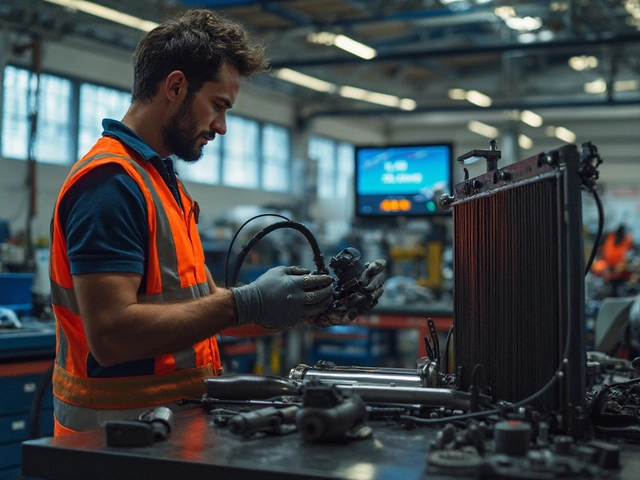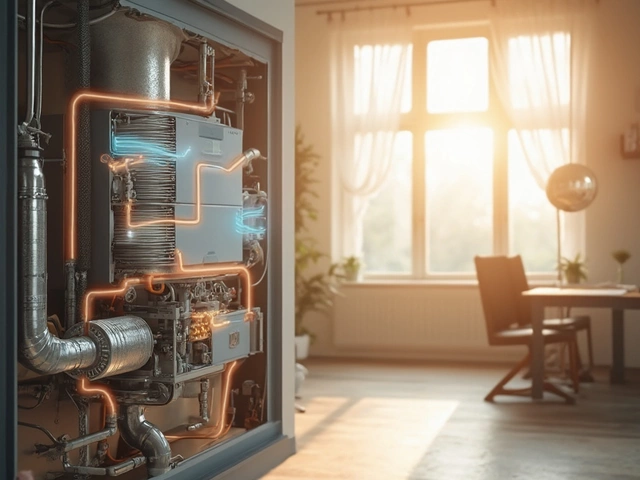Ever found yourself stuck on the side of the road, steam pouring out from under the hood? It’s like your car just decided to throw a tantrum. A bad radiator might be the culprit, and replacing it can be a real headache, both logistically and financially. But don't worry, I've got your back.
First things first, what’s eating up your cash when it comes to radiator replacement? It varies. A lot. Are you driving an everyday car or something more high-end? The make and model can seriously crank up those costs. Then there’s the big question: are you going for an OEM (original equipment manufacturer) radiator, or sticking to an aftermarket one? OEMs might offer peace of mind but tend to be pricier. Our wallet isn’t the only thing sweating, am I right?
And don't even get me started on labor costs. These can be all over the map depending on where you live. A quick tip—get a few quotes before handing over your keys. Who doesn’t love a good deal, right?
- Signs You Need a New Radiator
- Factors Affecting Replacement Costs
- DIY vs. Professional Repair
- Tips for Saving Money on Radiator Replacement
Signs You Need a New Radiator
So, you think your radiator's on its last legs? Well, let's break down the usual signs of trouble, so you know what to watch out for.
First up, the obvious one: overheating. If your car's temp gauge is climbing higher than it should, that’s a red flag. A bad radiator can’t dissipate heat properly, leading to that dreaded engine overheat light.
Another telltale sign? Coolant puddles where you park. If your car's leaving behind more than just a carbon footprint, you might have a radiator leak. Check your reservoir and hoses, too, because a crack can easily lead to coolant escaping.
"A radiator issue left unchecked can lead to significant engine damage," says auto mechanic expert Mike Taylor, "and that can cost way more than the radiator replacement itself."
Also, keep an ear out for unusual noises when your car is running. A clunking sound might mean parts inside the radiator are coming apart.
- Low coolant levels even after topping up—and no visible leak? It might be an internal problem.
- Rust or discoloration on the radiator. It’s not just about looks—a rusty radiator is a ticking time bomb.
- Warped or bent radiator fins, often from pebbles hitting your grille, are a subtle but serious sign of damage.
In short, pay attention to these signs, and consider getting your radiator replacement cost estimate sooner rather than later. It's better to act now than end up with a bigger, pricier problem down the line.
Factors Affecting Replacement Costs
So, you're looking at radiator troubles and wondering how deep you'll need to dig into your pockets? Well, let's break it down so you're not in the dark when you see that bill.
First off, your car's make and model plays a big role in what you'll pay. Driving a common sedan? You might catch a break on parts. But if you’re flaunting that luxury ride, get ready to cough up some extra dough. It's kind of like how a gourmet meal costs way more than a burger, right?
Then there's the decision between OEM or aftermarket radiators. OEM radiators are made by your car's manufacturer, meaning they're a perfect fit but also come with a higher price tag. Aftermarket ones are usually cheaper and might offer similar performance, but it’s a mixed bag in terms of quality. It's like choosing between name-brand and generic cereal at the store.
Labor costs also add up fast. Rates differ from shop to shop and are influenced by your location. If you're in a big city, expect to pay more than in a small town. A quick heads-up—ask for quotes from multiple garages. Many folks overlook this, but it can save you tons.
"The average cost for radiator replacement is between $678 and $933," says industry expert Jamie Brookes. "However, prices can swing widely based on the vehicle type and location."
Lastly, consider if there are any related repairs needed. Sometimes, issues linked to a bad radiator might require more fixes. Things like broken hoses or coolant leaks might pop up, and those will add to the bill.
Here's a quick view on how these factors can impact costs:
| Factor | Impact on Cost |
|---|---|
| Car Make/Model | Higher for luxury; lower for common models |
| OEM vs. Aftermarket | OEM tends to be more expensive |
| Location | Higher costs in urban areas |
| Related Repairs | Can add to the final price |
Keen to keep costs down? Be strategic and do a little homework before making decisions. Every dollar saved counts!

DIY vs. Professional Repair
So, you're staring at that leaky radiator—wondering if you should roll up your sleeves or call in the pros. Both choices have their perks and downfalls. Let's break it down.
If you're handy with tools and a fan of YouTube tutorials, going the DIY route might appeal. Not only could you save on labor costs, which typically range between $100 and $300, but you can also enjoy that sweet sense of accomplishment. Just make sure you have the right tools and a solid guide. Radiator replacement cost might be less about the part and more about how tricky your car's setup is. Some jobs are straightforward, but others... not so much.
You'd need a few essentials—basic hand tools, a leak-proof drain pan, a funnel, and the proper coolant. Preferably, get a buddy to help out, especially if it's your first crack at it. Be warned: mess it up, and it might end up costing you more than a professional job.
On the flip side, hiring a professional gives you peace of mind. They're pros for a reason; they’ve got the expertise and tools to ensure it's done right. Plus, most shops will offer some warranty on their work, which is a nice safety net. While it can be pricier due to labor and mark-up on parts, it's less stress, especially if car repairs aren’t your thing.
Deciding between these options largely depends on how confident you feel with wrenches and whether you’ve got time to spare. If you’re dealing with a quirky car model, sometimes it’s worth passing on the task to someone with experience. No shame in choosing convenience over potential headaches!
Tips for Saving Money on Radiator Replacement
If your radiator's on the fritz, you might be wondering how to get it sorted without gutting your bank account. Lucky for you, there are a few tricks to save some cash when dealing with a radiator replacement cost.
First off, shop around. Seriously, just because the nearest garage gives you a quote, doesn't mean you have to stick with it. Get quotes from a few places—sometimes a little competition works in your favor.
Consider buying parts yourself. There's often a markup on parts when you let the shop order them for you. Sites like RockAuto or even local auto parts stores can sometimes give you a better deal. Just ensure you're getting what fits your car's make and model.
- Aftermarket vs. OEM: Weigh the pros and cons here. While OEM parts might sound fancier, aftermarket parts often come much cheaper and work just as well. It doesn't hurt to research a bit and see reviews from other car owners.
- DIY If You Can: If you're handy with tools and know your way around your car, why not tackle the job yourself? It's not everybody's cup of tea, and you should definitely know what you’re doing. A mechanic might save you time, but doing it yourself saves cash.
- Caught Up On Maintenance: Regular maintenance might sound dull, but avoiding small issues that become major helps prevent radiator problems in the first place. Proper coolant levels and flushing the system regularly keep things running smoothly.
If you're the spreadsheet type, here's a general idea of what you might pay in various scenarios:
| Type | Cost Range (USD) |
|---|---|
| DIY (Parts Only) | 100 - 300 |
| Professional (Labor & Parts) | 400 - 1,000 |
| OEM Parts | 150 - 800 |
| Aftermarket Parts | 70 - 250 |
Remember, being proactive and doing a little bit of legwork can make a world of difference in keeping that radiator replacement cost manageable. Happy driving, and may your car stay cool on the road.






